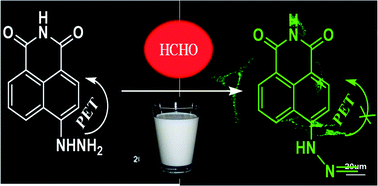A two-photon fluorescent probe for imaging of endogenous formaldehyde in HeLa cells and quantitative detection of basal formaldehyde in milk samples†
Abstract
Herein, a two-photon fluorescent probe NaP for formaldehyde (FA) was rationally constructed and reported. The probe presented favorable properties responding to FA, such as a remarkable ∼29-fold fluorescence signal enhancement at 550 nm, good selectivity, high sensitivity and a low detection limit which was calculated to be 1.62 × 10−6 M. Furthermore, the probe NaP was membrane-permeable and successfully employed for visualization of endogenous FA in living cells. Meanwhile, the FA content in six milk samples was quantitatively detected and the accuracy was assessed by the 3-methyl-2-benzothiazolinone hydrazone (MBTH) method, which is a standard UV spectrophotometric method. As expected, the proposed probe NaP may serve as a promising tool for imaging of endogenous FA in living systems and quantitative detection of FA in the food industry.

- This article is part of the themed collection: Analytical Methods Recent HOT articles


 Please wait while we load your content...
Please wait while we load your content...